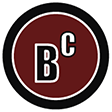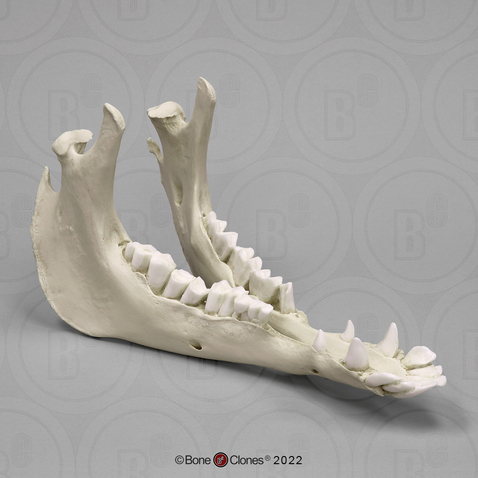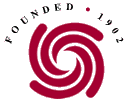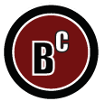-
Fields of Study
- K-12 Education
- Advanced Anatomy
- Forensics
- Physical Therapy
- Primate Locomotion
- Non-primate Locomotion
- Biological Anthropology
- Paleontology
- Bioarchaeology
- Marine-Aquarium
- Veterinary
-
Zoology
- All Zoological Items
- Endangered Species
- Skulls
- Skeletons
- Cranial Elements
- Postcranial Elements
- Eggs
- Limbs
- Teeth & Fangs
- Claws & Talons
- Brains & Endocasts
- Life Casts
- Pathology & Trauma
- Wildlife Forensics
- Sets
- Bird Sets
- Accessories
- Birds
- Mammals
- Reptiles & Amphibians
- Fish
- Sharks & Rays
- Turtles & Tortoises
- Anatomy for the Artist
- Decor
- Veterinary
- Elements
- Pathology & Trauma
-
Sets & Series
- Natural History Gift Ideas
- Decor
- Scale & Sculpture
- 3D Scanned & Printed
- Bone Boxes
- Locomotion Sets
- Forensic Sets
- Advanced Anatomy Sets
- Physical Therapy Series
- Fetal Sets
- Economy Series
- Zoology Sets
- Bird Sets
- Claw & Talon Sets
- Tooth & Fang Sets
- Primate Skull Sets
- Fossil Hominid Sets
- B.I.O.P.S.I. - Babiarz Institute
- Maxwell Collection
- Bergdorf Goodman Windows
- Accessories
- New Products
-
Our Company
- News & Specials
- Printable Handouts
- About Us
- Why Choose Bone Clones
- Bone Clones in the News
- Mission
- Contact Us
- Privacy and Security
- FAQs
- Testimonials
- Community Outreach
- Legal/Copyright
- Flyers
- Choosing Original Specimens
- Museum Exhibitions
- Natural History Gift Ideas
- About the Economy Series
- Acknowledgements
- Ordering & Delivery
- Warranty
- Refund/Return Policy
- Price List at a Glance
- Our Catalog
- Osteological Evaluation Reports
- About 3D Printing
- Sawyer & Maley Neanderthal Reconstruction
- Site Introduction
- Newsletter Archive
-
Human Anatomy
- All Human Anatomy
- Human Skulls
- Human Skeletons
- Head & Neck
- Postcranial Elements
- Advanced Anatomy
- Physical Therapy / Joints
- Human Brains & Endocast
- Human Life Casts
- Maxwell Museum
- Sets & Series
- Accessories
- Osteological Evaluation Reports
- Featured
- Adult Human Anatomy
- Adolescent Human Anatomy
- Child Human Anatomy
- Fetal Human Anatomy
-
Zoology
- All Zoological Items
- Endangered Species
- Skulls
- Skeletons
- Cranial Elements
- Postcranial Elements
- Eggs
- Limbs
- Teeth & Fangs
- Claws & Talons
- Brains & Endocasts
- Life Casts
- Pathology & Trauma
- Wildlife Forensics
- Sets
- Bird Sets
- Accessories
- Birds
- Mammals
- Reptiles & Amphibians
- Fish
- Sharks & Rays
- Turtles & Tortoises
- Fossil Hominids
- Paleontology
- Non-human Primates
- Forensics
All items sold on this website are replicas; no real/natural bone is available on this site. Bone Clones® are 1:1 scale unless stated otherwise. All Bone Clones® products are made in the USA.
 ALSO SEE:
ALSO SEE:
Arabian Camel, Dromedary Jaw
BC-355-J $201.00
The Dromedary camel (also known as the Arabian Camel) lives in the arid regions of the Middle East and in the Saharan Desert of Africa.
Juvenile camels have 22 milk teeth and by 5 years old, will have 34 permanent teeth. The lower jaw of a camel presents a weak point between the front teeth and the cheekteeth. During rut, some irritable male camels are compelled to bite hard objects and consequently fracture their jaw at this vulnerable point. In addition to antemortem missing teeth, an abscess is evident in this specimen’s jaw.
Domestication of the Dromedary camel occurred about 4,000 years ago in Abu Dhabi and the northern portion of the Arabian Peninsula and are still used for transport across arid environments.
| Scientific Name | Catalogue # | Size | Price |
| Camelus dromedarius | BC-355-J | 16" L x 7" W x 8 ½" H 41L x 18W x 22H (cm) | $201.00 |
Related Products:
-
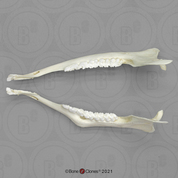 Deer Jaws Comparative Pathology Set
Deer Jaws Comparative Pathology Set -
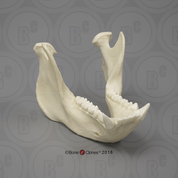 Western Lowland Gorilla Mandible, Male
Western Lowland Gorilla Mandible, Male -
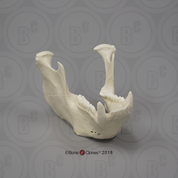 Male Sumatran Orangutan Mandible
Male Sumatran Orangutan Mandible -
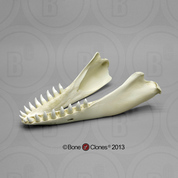 False Killer Whale Whole Lower Jaw
False Killer Whale Whole Lower Jaw -
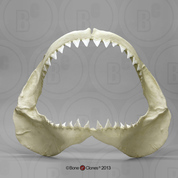 Great White Shark Jaw
Great White Shark Jaw -
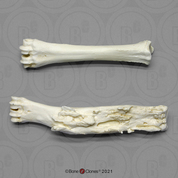 Goat Cannon Bones (metatarsals) Comparative Pathology Set
Goat Cannon Bones (metatarsals) Comparative Pathology Set -
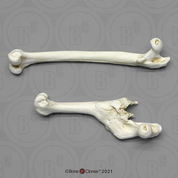 Baboon Femurs Comparative Pathology Set
Baboon Femurs Comparative Pathology Set -
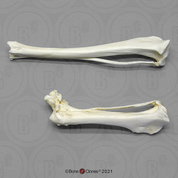 Coyote Tibiae and Fibulae Comparative Pathology Set
Coyote Tibiae and Fibulae Comparative Pathology Set -
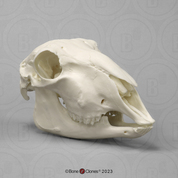 Economy Sheep Skull
Economy Sheep Skull -
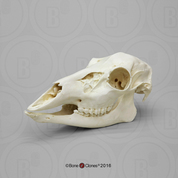 White-tailed Deer Doe Skull
White-tailed Deer Doe Skull -
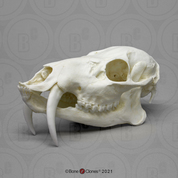 Chinese Water Deer Skull
Chinese Water Deer Skull -
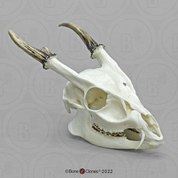 Muntjac Skull
Muntjac Skull -
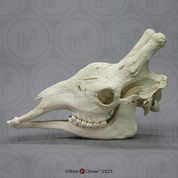 Giraffe Skull
Giraffe Skull -
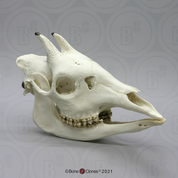 Okapi Skull
Okapi Skull -
 Cave Myotis Bat Skull, 8:1 Scale
Cave Myotis Bat Skull, 8:1 Scale
Newsletter Signup
9200 Eton Ave.
Chatsworth, CA 91311 USA
© 1992-2025 Bone Clones Holdings. All Rights Reserved.
Customer Service
© 2025 BONE CLONES HOLDINGS / Made by MEV


